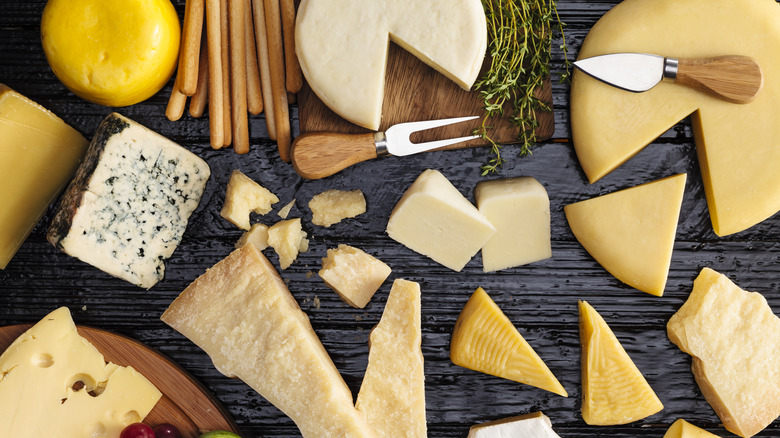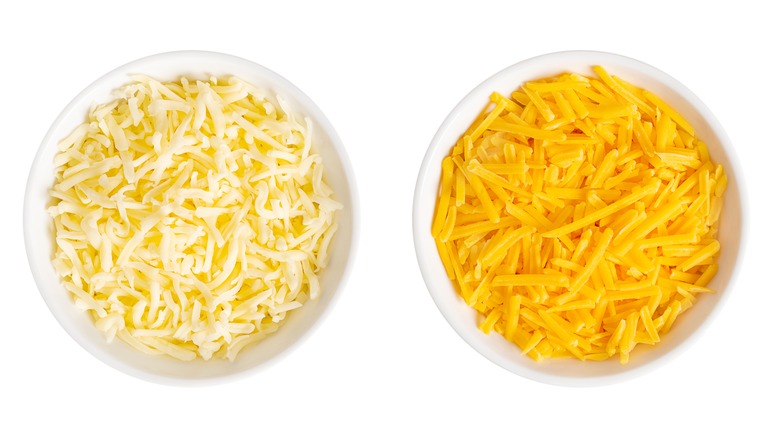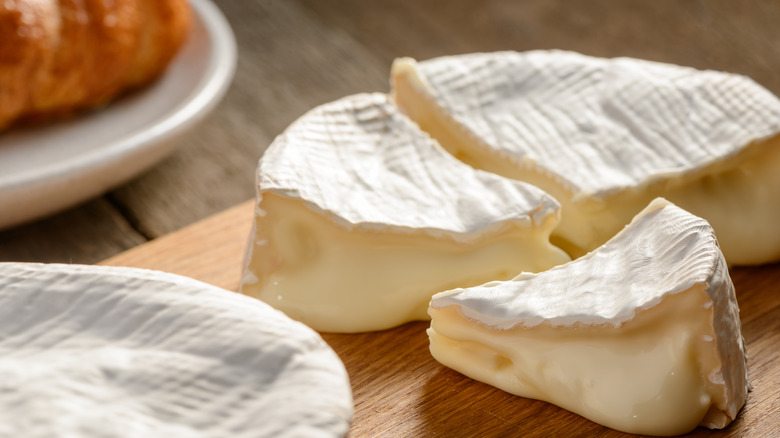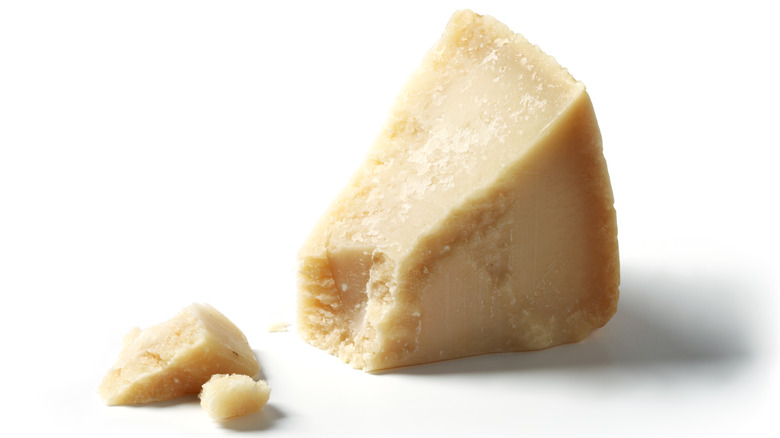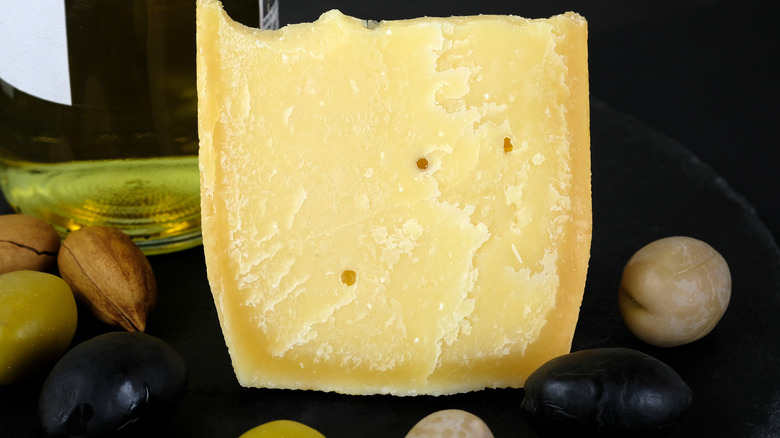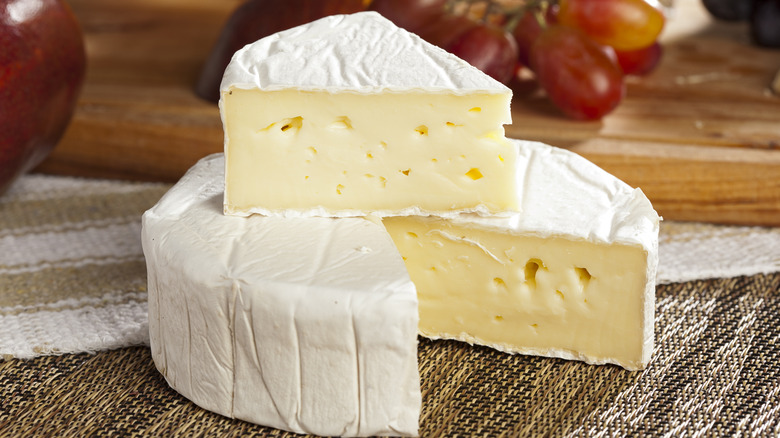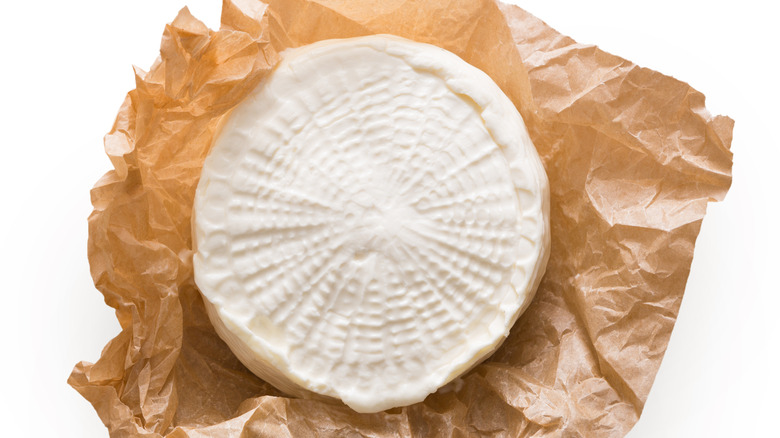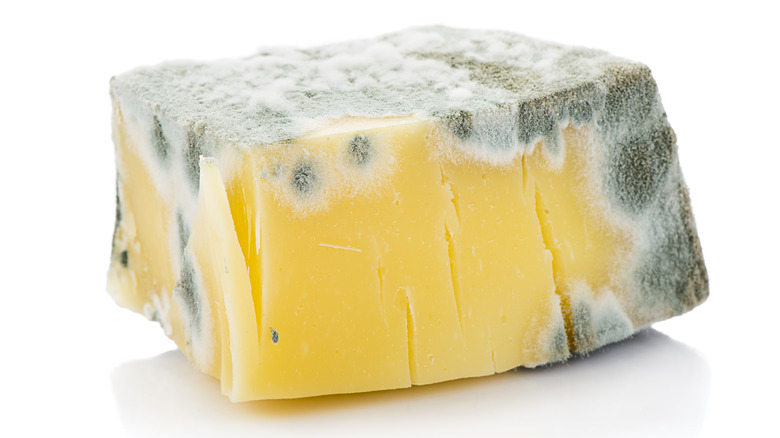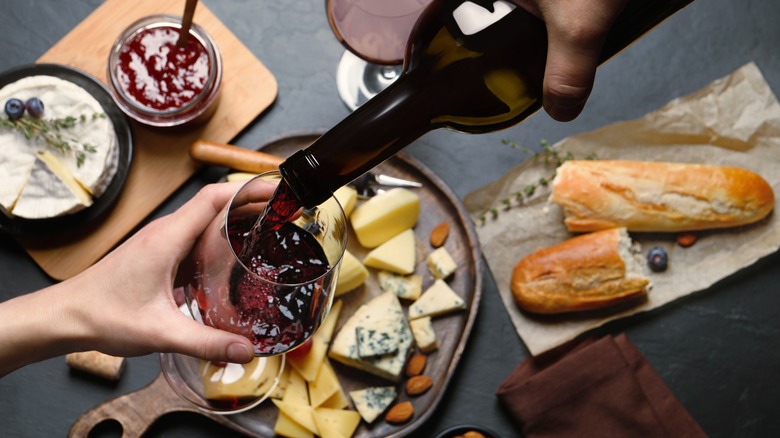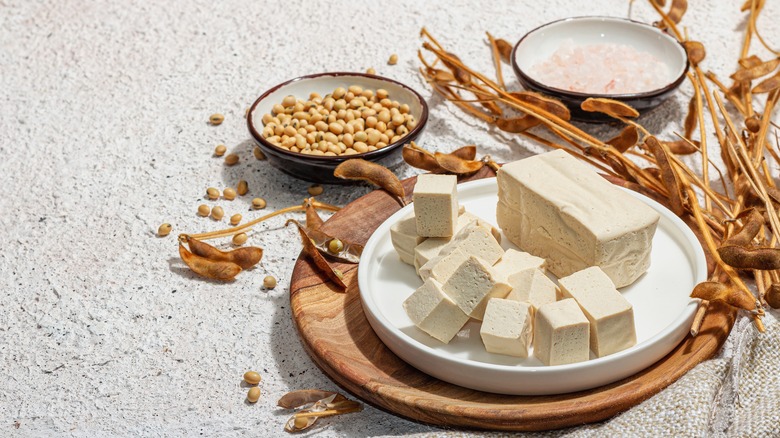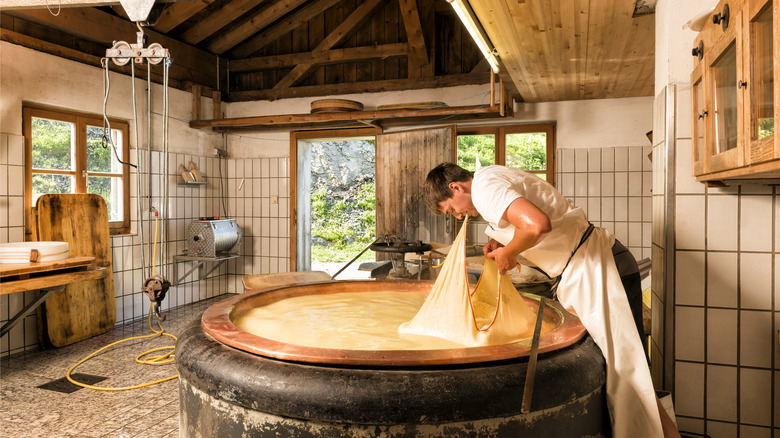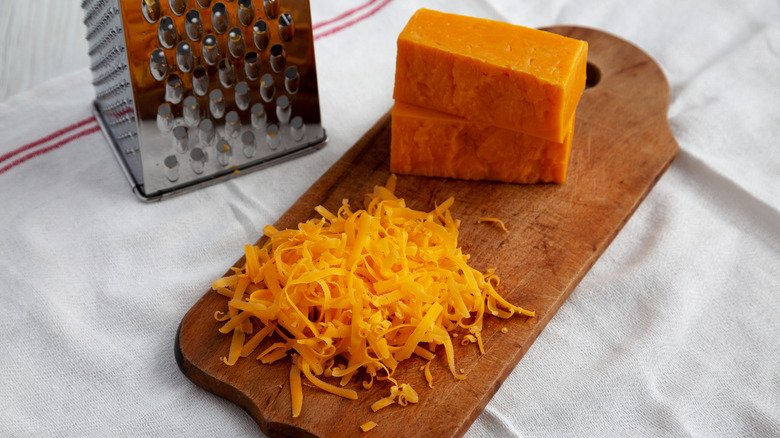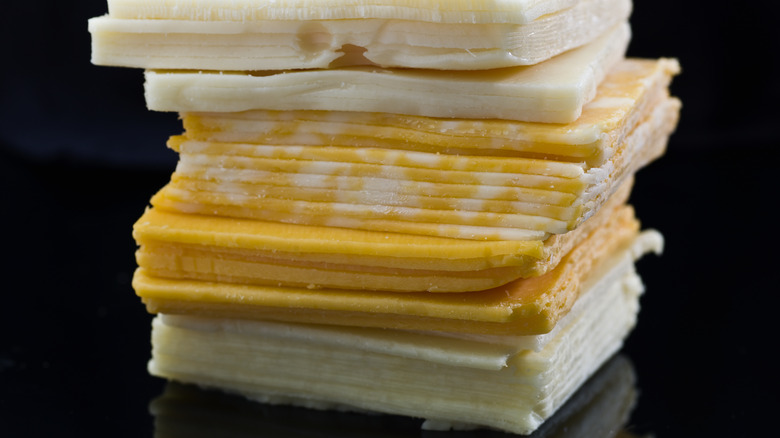False Facts About Cheese You Thought Were True
Social media is forever abuzz with the newest cheese craze, from baked feta and pornographic cheese pulls to maximalist pasta finished in hollowed-out cheese wheels. It seems no food makes people go quite as gaga as cheese. And with over a thousand different products that are at their core, merely spoiled milk, the category of cheese is rife for exploration.
But as with any food this popular, the cheese landscape is also punctuated by myths and legends, only some of which hold water. While much was made of a study that seemed to frame cheese as being as addictive as hard drugs, the reality (perhaps unsurprisingly) is that these conclusions were exaggerated at best. While this myth was fairly easily debunked, some fromage facts that seem far more believable at the outset are actually totally false. Want to know which stories are as holey as Swiss cheese? Here are some of the top contenders for the cheesiest myth.
Myth: Some cheeses are naturally orange
Americans and Brits are accustomed to orange cheese, as any stroll through the local dairy aisle will show. Shades of beige and a few small pops of orange appear in the form of cheddar, Red Leicester, Shropshire Blue, or French Mimolette. But despite the omnipresence of this rusty hue, it turns out that orange cheeses are far from natural.
Coloring cheese orange was originally a marketing trick dating back as far as 16th century England. Spring and summer milk is naturally richer in beta-carotene, given the grass-fed diet of cows. In winter, milk tended to be whiter, so enterprising producers decided to give it a little help and make it a touch more appetizing. This was further compounded by the fact that some dairy producers realized they could make more money by skimming the cream off their milk and selling it as-is or in the form of butter. This process further reduced the natural golden color of their cheese, making the food coloring all the more necessary.
Originally, cheesemakers took advantage of turmeric, carrot juice, or saffron to tint their cheese orange. In the 18th century, most cheese producers turned instead to South American annatto to infuse a golden hue without any added flavor, and today, annatto still gives orange cheddar its recognizable color.
Myth: You can't eat cheese if you're lactose intolerant
Lactose intolerance is no picnic ... but if you suffer from the ailment, there is some good news: You don't necessarily have to avoid all cheese. Lactose intolerance sufferers produce insufficient lactase, a gut enzyme that helps break down lactose, aka milk sugar. Without it, one may suffer uncomfortable digestive symptoms including bloating, gas, and diarrhea.
The good news is that while lactose intolerance may make it tough to drink a milkshake, the very process of cheesemaking removes much of the lactose in the milk. First, some lactose is strained off the curds when the whey is removed. Next, the aging process transforms lactose into lactic acid, which — good news! — does not rely on lactase to digest. After two months of aging, most cheeses are relatively devoid of lactose.
This, of course, does not hold for all cheeses. Processed products like American cheese may have some skim milk or whey added to help them melt better, thus making them harder to digest. And very young cheeses like ricotta or mozzarella haven't aged long enough for the lactose to fully convert to lactic acid. It also bears mentioning that while the lactose in cow's milk can be tough to tolerate, the same compound in goat's and sheep's milk is far easier on the stomach. Manchego has double the benefit of being made with sheep's milk and aging over several months, making it a great choice.
Myth: Soft cheeses are higher in fat than hard cheeses
It's tempting to assume that the ooze of a great Brie or Camembert comes from its high-fat content, but if you think fat makes cheese fluid, you'd be mistaken. Runny cheeses get their texture due not to more fat but rather a higher water content. In reality, it's the dense, harder cheeses like aged cheddar or Parmesan that have more fat, with cheddar typically boasting about 35% fat as compared to just 30% fat in a cheese like Brie. It's no surprise that the best Comtés and Gruyères melt in such a beautiful, buttery way.
The exception to this general rule is the category of double- or triple-cream cheeses. As the name suggests, these have been enhanced with cream for an even more luxurious texture. That said, even a triple cream Brie holds no candle to cheddar, with just 32% fat; the rest of that rich character is just water.
Myth: Parmesan and Parmigiano Reggiano are the same thing
A beloved topping for pasta, Parmesan cheese has more than earned its rep as the king of Italian cheeses. But while it's fairly evident that the shelf-stable jar and the massive wedge you'll find at your local Whole Foods aren't the same, the truth is the world of Parmesan is murkier than it seems.
Parmigiano Reggiano is the name of the PDO (Protected Designation of Origin) cheese made exclusively in five regions of Italy: Parma, Modena, Reggio Emilia, Bologna, and Mantua. This cheese is made according to strict rules; it must be made with raw milk, and it undergoes strict quality controls to ensure it adheres to the expected flavors and permitted methods of true Parmigiano production.
Parmesan, on the other hand, is not a regulated term. This cheese can be made anywhere — including in the U.S. — and is usually significantly cheaper than true Parmigiano Reggiano, which retails for about $1,000 a wheel. Some American-made Parmesans, like Wisconsin's Sartori, are indeed admirable, winning multiple awards like a Gold medal at the 2016 Global Cheese Awards. However, others are known for cutting corners in unpalatable ways, notably pre-grated versions that have been bulked out with cellulose, aka wood shavings.
Myth: Cheddar is flecked with salt crystals
A truly delicious cheddar or Parmesan often stands out thanks to its texture, boasting lovely, crunchy crystals in every bite. But while these crystals may crunch like fleur de sel, this texture doesn't come from salt. Cheese is indeed salty — your average cheddar contains 190 milligrams of sodium per ounce. But the salt is added so early on in the cheesemaking process that it would hardly remain whole and crunchy after weeks, months, or even years of aging. So what are those little crunchy bits in your cheese?
The answer is ... it depends. In the case of cheeses like cheddar, these crystals are generally calcium lactate, which forms as lactose breaks down and lactic acid begins to form. This acid binds with calcium ions in the cheese, and calcium lactate forms, mainly on the surface. These little crystals don't taste like much in and of themselves, but their presence is a good sign the cheese has loads of aroma.
When it comes to Italian Parmigiano Reggiano, Dutch Gouda, or Swiss-style Gruyère or Comté, this crystallization comes instead in the form of tyrosine, an amino acid with loads of crunch. These crystals tend to be found not on the surface of the cheese but rather in the center. Since tyrosine is used by the body to create dopamine, a hormone associated with pleasure, its presence can increase your perception of the deliciousness of a cheese.
Myth: You should trim off Brie's rind
The rinds of some cheese, like Comté and Parmesan, are too hard to be enjoyed easily (though these rinds work wonderfully to suffuse soups and stews with flavor). But in the case of other cheeses, the rind is part and parcel of the eating experience. Such is the case with the white exterior of Brie.
Brie is a member of the bloomy-rinded family of cheese, a category that also includes French Camembert and American Mt. Tam. The white rind comes from a combination of molds like Penicillium candidum or Penicillium camemberti and fungi like Geotrichum candidum. While that might not sound super appetizing, the reality is that these little microorganisms lend loads of flavor to these cheeses, particularly a woodsy, mushroomy aroma.
Not only is the rind of Brie edible, but it's also delicious. Carving it away isn't just a bad idea — it's also kind of rude. If you find it tough to swallow, you don't have to eat it ... but you shouldn't be scooping the inside of the cheese out and leaving the rind behind. Instead, serve yourself a slice and discreetly pare the rind away, leaving it on your plate rather than the communal board.
Myth: Cheese should be stored in plastic wrap
Often, when you buy cheese in a supermarket or even in a cheese shop, it comes vacuum-sealed in plastic. Consequently, it's no surprise that so many people believe that plastic wrap is the best way to keep cheese safe and sound in the fridge. But friends, you'd be wrong. Cheese is alive; it needs to breathe. Wrapping it in plastic keeps it from doing just that. Storing it so tightly bound may encourage mold to form and develop on the surface of the cheese, which may make it go bad more quickly.
Instead, wrap cheese in parchment paper, waxed paper, or even cheese paper, which you can get from your cheesemonger. This will help the cheese retain its moisture balance, neither becoming too damp nor drying out in your fridge. Blue cheeses can also be wrapped in aluminum foil, which is a particularly good idea for wetter blues like Roquefort. If you're worried about your cheese stinking up the fridge, you can also keep it in a sealed plastic container.
Myth: You can't eat moldy cheese
From the rind of Brie to the blue veins in Gorgonzola, mold is pretty omnipresent in cheese from the get-go. But what about when a piece you've had sitting in the fridge develops a new patch of white, blue, red, or even black mold? While it's not advised to consume any mold that wasn't there when you bought the cheese, you don't have to toss the whole piece just because it's developed some new color.
The U.S. Department of Agriculture (USDA) recommends trimming an inch around the moldy spot on any hard cheeses and discarding only this portion, retaining the rest of the cheese to enjoy (quickly). Other sources say you can just scrape the mold away, noting that with soft cheeses, it's best to cut away at least a quarter-inch if there are any moldy spots. In any case, white or green mold is far less worrisome than anything black or gray, which you'll want to remove entirely.
When it comes to soft, creamy cheeses like ricotta, cream cheese, or chèvre, however, it's best to err on the side of caution and toss the whole container in the trash, seeing as the mold can proliferate quickly in this damp environment. The same holds for any pre-shredded or pre-grated cheese, which is likely contaminated far past what's visible to the naked eye.
Myth: Red wine is the best pairing for cheese
While red wine has long seemed like the perennial pairing for a cheese board, the reality is that this combo is rarely ideal. The presence of tannins in red wine tends to bring out bitter notes, due to the lactic ferments in the cheese that highlight the wine's natural astringency. While some red wine-and-cheese pairings can work, such as a light-bodied gamay with funky Swiss or a fruity pinot noir with Parmesan or blue, cheese tends to be far happier when paired with white wine, which doesn't have the same tannic structure as red.
But you don't need to limit yourself to wine as a pairing for cheese. The effervescence of Champagne or even beer sweeps the palate, making it perfect for the rich, complex flavors of cheese. The acidity and funk of a sour ale work well with fatty burrata or double-cream Mt. Tam, while robust stouts with their sweet cocoa notes are a natural pairing for blue cheese. Cider, too, goes great with cheese, especially those that are harder to pair with wine, like Camembert. Cheese can even be paired with non-alcoholic beverages, like tea: A fermented pu-erh is smoky and earthy, bringing out similar flavors in washed rind cheeses like Époisses.
Myth: Cheese gives you nightmares
The idea that cheese gives you nightmares is an oft-repeated old wives' tale, linked in the minds of many, to the bacterial cultures that give cheese its flavor and funk. For this reason, blue cheese is said to be the guiltiest party in turning your sweet dreams sour. One 1964 report in the British Medical Journal did indeed seem to show a correlation between cheese consumption and bad dreams. It hinged on the experiences of one man who ate an ounce or two of cheddar every evening and suffered horrible nightmares. The moment he removed cheese from his diet, he was miraculously cured.
But according to experts, this link is far from verifiable. If anything, cheese seems to improve sleep quality, at least according to a 2020 study in the International Journal of Environmental Research and Public Health. Psychologist and sleep scientist Theresa Schnorbach hypothesizes this may be due to the presence of tryptophan, which is a precursor to melatonin, the hormone that helps our bodies know it's time to go to sleep. And while eating anything late at night is likely to contribute to sleep disturbances, choosing cheese isn't necessarily going to make your dreams any scarier.
Myth: Cheese is vegetarian
While proponents of a vegan diet eschew anything but plant-based cheese, vegetarians may want to avoid some members of the category as well due to the presence of an ingredient known as rennet. Rennet contains enzymes that help force milk to coagulate, essentially transforming it into cheese. In most traditional cheesemaking practices, the substance is sourced from the stomach linings of young ruminants, like calves, lambs, and kids. The young animals must be slaughtered to obtain it (and the meat), which means the cheese is not suitable for consumption by vegetarians.
Luckily, there are other options out there. Some cheese producers use vegetarian rennets, which may be derived from plants like artichokes or thistles. Microbial rennets made from mold or yeast can also be used. Genetic engineering has given rise to fermentation-based rennet, which emulates animal rennet by genetically engineering bacteria, fungi, or yeast to produce the same compounds. Lactic-fermented cheeses like some chèvres are made entirely without rennet. All that to say, if you're avoiding cheese because of issues with animal rennet, you've got options.
Myth: Raw milk cheeses are dangerous
While raw milk cheeses are fairly omnipresent in countries like Switzerland, Italy, and France, strict laws in the U.S. preclude most places from selling any raw milk cheese aged less than 60 days. This has led many consumers to believe that raw milk cheeses, also known as unpasteurized cheeses, are unsafe. But this is far from the whole story.
Most cheese sold in the U.S. is made from milk that has been pasteurized, a process that heats the milk to kill off any microbes, including dangerous pathogens like listeria and E. coli. But the question we should be asking ourselves is how these pathogens got into the milk in the first place.
The factory farm industry in the U.S. sees many dairy cows kept in poor conditions that contribute to a rise in these and other pathogens, making pasteurization a necessity to keep them out of milk and cheese. But when raw milk is produced cleanly and responsibly, it's just as safe, if not safer, than pasteurized. The flavors of raw milk cheese, which retain all of the good microorganisms that link it to its terroir, are truly incomparable to pasteurized.
Myth: Cheddar is the best-selling cheese in America
From homemade omelets to burgers to mac and cheese, cheddar is omnipresent on the American market. And that makes sense even though it didn't originate here. Cheddar was invented in England in the 12th century in and around the village of Cheddar, Somerset, and made its way to America as early as the 18th century. Soon, it became a local favorite too. The world's first cheese factory was a New York cheddar-making facility, and these days cheddar is made across the country.
Cheddar is certainly popular in the U.S., with nearly 10 pounds available per person in 2011, according to the USDA. That same year, it ranked as America's second-most-popular cheese, surpassed by mozzarella, with 11.5 pounds available per American. Seeing as mozzarella is the ideal topping for what one poll found was America's favorite food, pizza, it's unsurprising that the dish's key ingredient tops the list.
Myth: American cheese isn't real cheese
Plastic-wrapped slices of bright orange American cheese are often described in less than tantalizing ways by turophiles, with some evoking their plasticine texture, long shelf life, neon color palette, and unnatural melting capabilities, as just some of the reasons they should be categorized, not as cheese, but rather as a cheese product. But while American cheese does indeed include other ingredients, like added milk, cream, whey, or emulsifying salts, there is an argument for letting it be called cheese.
Processed cheese got its start, not in America, but rather in Switzerland, where, in an effort to reduce food waste, cheese scraps were melted together to create a cheese-derived product. The process was perfected and patented by James Kraft in 1916, bringing the product to America, with which it is now most often associated. These days, processed cheese does indeed begin with real cheese.
Of course, not all American cheese is created alike. Strict labeling guidelines established by the Food & Drug Administration dictate what can and cannot be included in four categories of similar sliced cheese products. "Pasteurized process cheese" is the one with the shortest ingredient list, seeing cheese combined with cream, water, salt, food coloring, spices, and an emulsifying agent. It's by many accounts the perfect ingredient to give your grilled cheese sandwiches the ideal gooey texture.
